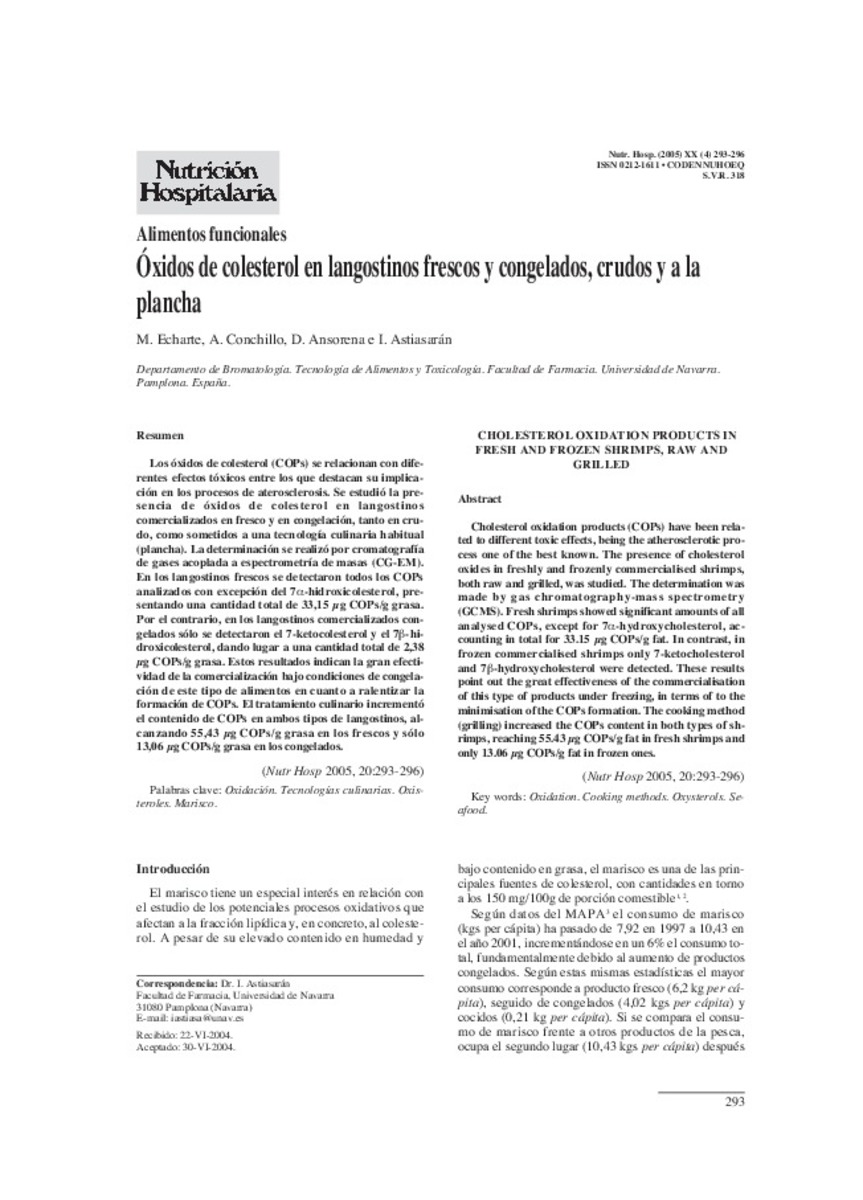Full metadata record
| DC Field | Value | Language |
|---|---|---|
| dc.creator | Echarte, M. (Maider) | - |
| dc.creator | Conchillo, A. (Ana) | - |
| dc.creator | Ansorena-Artieda, D. (Diana) | - |
| dc.creator | Astiasarán, I. (Iciar) | - |
| dc.date.accessioned | 2015-03-02T15:07:48Z | - |
| dc.date.available | 2015-03-02T15:07:48Z | - |
| dc.date.issued | 2005 | - |
| dc.identifier.citation | Echarte M, Conchillo A, Ansorena D, Astiasarán I. Óxidos de colesterol en langostinos frescos y congelados, crudos y a la plancha. Nutr Hosp 2005;20(4):293-296 | es_ES |
| dc.identifier.issn | 0212-1611 | - |
| dc.identifier.uri | https://hdl.handle.net/10171/37713 | - |
| dc.description.abstract | Los óxidos de colesterol (COPs) se relacionan con diferentes efectos tóxicos entre los que destacan su implicación en los procesos de aterosclerosis. Se estudió la presencia de óxidos de colesterol en langostinos comercializados en fresco y en congelación, tanto en crudo, como sometidos a una tecnología culinaria habitual (plancha). La determinación se realizó por cromatografía de gases acoplada a espectrometría de masas (CG-EM). En los langostinos frescos se detectaron todos los COPs analizados con excepción del 7-hidroxicolesterol, presentando una cantidad total de 33,15 μg COPs/g grasa. Por el contrario, en los langostinos comercializados congelados sólo se detectaron el 7-ketocolesterol y el 7-hidroxicolesterol, dando lugar a una cantidad total de 2,38 μg COPs/g grasa. Estos resultados indican la gran efectividad de la comercialización bajo condiciones de congelación de este tipo de alimentos en cuanto a ralentizar la formación de COPs. El tratamiento culinario incrementó el contenido de COPs en ambos tipos de langostinos, alcanzando 55,43 μg COPs/g grasa en los frescos y sólo 13,06 μg COPs/g grasa en los congelados. | es_ES |
| dc.description.abstract | Cholesterol oxidation products (COPs) have been related to different toxic effects, being the atherosclerotic process one of the best known. The presence of cholesterol oxides in freshly and frozenly commercialised shrimps, both raw and grilled, was studied. The determination was made by gas chromatography-mass spectrometry (GCMS). Fresh shrimps showed significant amounts of all analysed COPs, except for 7-hydroxycholesterol, accounting in total for 33.15 μg COPs/g fat. In contrast, in frozen commercialised shrimps only 7-ketocholesterol and 7-hydroxycholesterol were detected. These results point out the great effectiveness of the commercialisation of this type of products under freezing, in terms of to the minimisation of the COPs formation. The cooking method (grilling) increased the COPs content in both types of shrimps, reaching 55.43 μg COPs/g fat in fresh shrimps and only 13.06 μg COPs/g fat in frozen ones. | es_ES |
| dc.language.iso | spa | es_ES |
| dc.publisher | Sociedad Española de Nutrición Parenteral y Enteral | es_ES |
| dc.rights | info:eu-repo/semantics/openAccess | es_ES |
| dc.subject | Oxidación | es_ES |
| dc.subject | Tecnologías culinarias | es_ES |
| dc.subject | Oxisteroles | es_ES |
| dc.subject | Marisco | es_ES |
| dc.subject | Oxidation | es_ES |
| dc.subject | Cooking methods | es_ES |
| dc.subject | Oxysterols | es_ES |
| dc.subject | Seafood | es_ES |
| dc.title | Óxidos de colesterol en langostinos frescos y congelados, crudos y a la plancha | es_ES |
| dc.type | info:eu-repo/semantics/article | es_ES |
| dc.identifier.doi | http://dx.doi.org/10.3305%2Fnutr+hosp.v20in04.3582 | es_ES |
Files in This Item:
Statistics and impact
Items in Dadun are protected by copyright, with all rights reserved, unless otherwise indicated.






